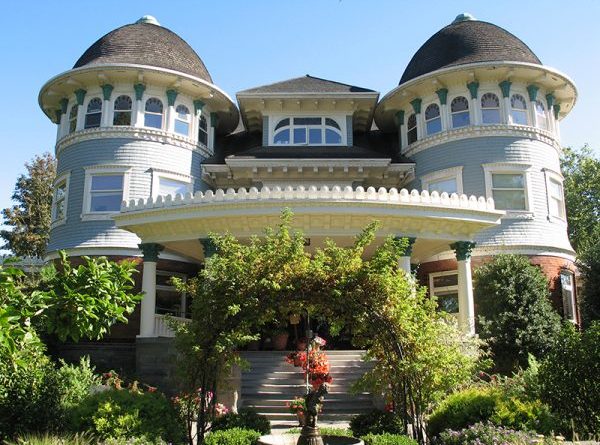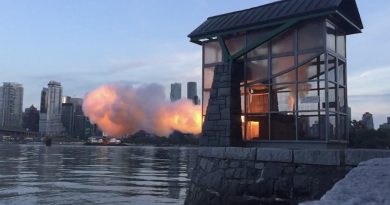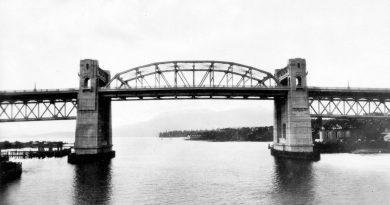Glen Brae
There are people who’ve lived in Vancouver all their lives and never seen it, yet 2005 marks the 95th anniversary of the dramatic double-domed Shaughnessy giant, the Tait Mansion.
A retired B.C. lumberman named William Lamont Tait built the place, and critical reception to it was mixed right from the start. There are some who think it’s the ugliest house in Vancouver, some who think it’s beautiful—and some, like me, who simply stand looking at it, open-mouthed.
Tait had no doubts at all—he loved it. To set it off properly from its more prosaic Shaughnessy neighbors, he had an enormous wrought-iron fence imported from Scotland and placed along the Matthews Avenue front of the mansion.
In 1973, Mrs. E.H. Daniel told Aileen Campbell of The Province that, as a child, she’d lived in the house next to Glen Brae and saw Tait often: “He was retired when he moved in. He was a great gardener—very proud of his house and wrought-iron fence. He was a great man to say how much things cost. There were rosettes in gold leaf on the fence. It was brought from Scotland at a cost of $10,000. I remember as a child being very impressed. That was a lot of money . . .”
But that was just the fence. There were 18 rooms in Glen Brae, one of them a ballroom that took up the entire third floor. With a decent regard for the tender tootsies of their dancing guests, the Taits had the ballroom floor underlaid with a thick and flexible layer of seaweed. I walked around on that floor during a visit many years ago and, even carpeted, could feel it give slightly under my feet.
Tait’s lavish tastes are evident throughout the house. How much of its style comes from him and how much from its architects, Parr and Fee, isn’t recorded. One of the mansion’s six bathrooms has a huge stained-glass window of a sailing scene. There is an attractive three-metre stained glass window in the west wall showing a rural scene somewhere in Ontario.
Tait died in 1919, his wife died the next year and the house began a slow decline. Dust gathered on the stained-glass windows, the Italian crystal doorknobs, brass chandeliers, baked and polished brick, a $16,000 embroidery of Victoria Falls—and one of British Columbia’s first elevators. (It had been installed for the disabled Mrs. Tait, who had lost a leg.)
All of these amenities gave Glen Brae a richness at odds with its fate in 1925: It became the Canadian headquarters of the Ku Klux Klan.
In the fall of 1925, the Invisible Empire of the Kanadian Knights of the Ku Klux Klan paraded en masse up Granville Street to take up residence in their gorgeous new headquarters. They held an “informal reception” there on Oct. 30. “They paraded on the grounds in their white robes,” one neighbor recalled, “carrying fiery crosses of red electric lights. We saw them coming in their white hoods with the black eyeholes. It left a very lasting impression.”
KKK membership in Vancouver was said to be 8,000 at its peak—this is likely an exaggeration. At any rate, a local bylaw was passed prohibiting mask-wearing and the number of Klan members dwindled to about 200. The sheeted twits were out of Glen Brae in less than a year, even though their rent was only $150 a month.
In 1929, a kindergarten was renting the place for $75 a month. I have an old newspaper advertisement in my files showing the house as a prize in a raffle, with tickets at $1 each!
Glen Brae next popped up in the news during the 1930s. In honor of a rising new star of the silver screen, people began to call it The Mae West House. You can guess why.
In 1980 the mansion became the Glen Brae Private Hospital, occupied by a number of elderly women. The elevator became a dumbwaiter, used to bring the ladies’ food from the kitchen. The owners, Julian and Elisabeth Wlosinski, lived upstairs, turned the 15-metre long ballroom into their living room, flanked by two bedrooms, each of which boasted 10 arched windows.
Glen Brae—designated a Heritage Building some years ago—is in fine shape. In 1991, before her death, Elisabeth Wlosinski willed this awesome home to the City of Vancouver. In November 1995 Canuck Place opened as North America’s first free-standing children’s hospice. To this day, it remains the model for children’s hospices in North America providing hospice care free of charge to children and their entire families. Today, it is regarded as one of the leading children’s hospices in the world. See the web site www.canuckplace.org. It includes a short video explaining the hospice’s function, showing the kids it cares for, and includes a virtual tour.




